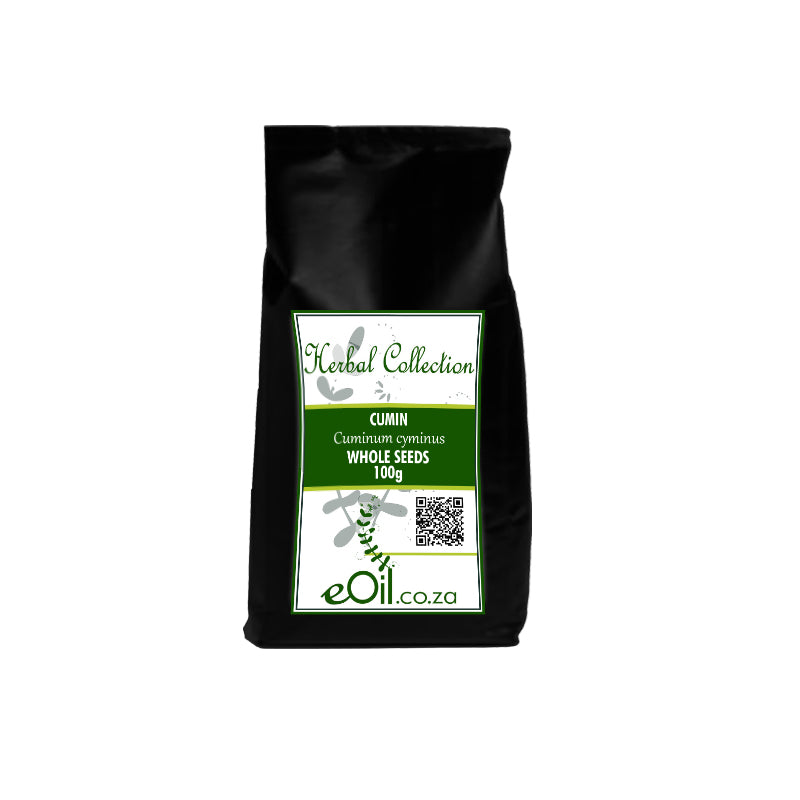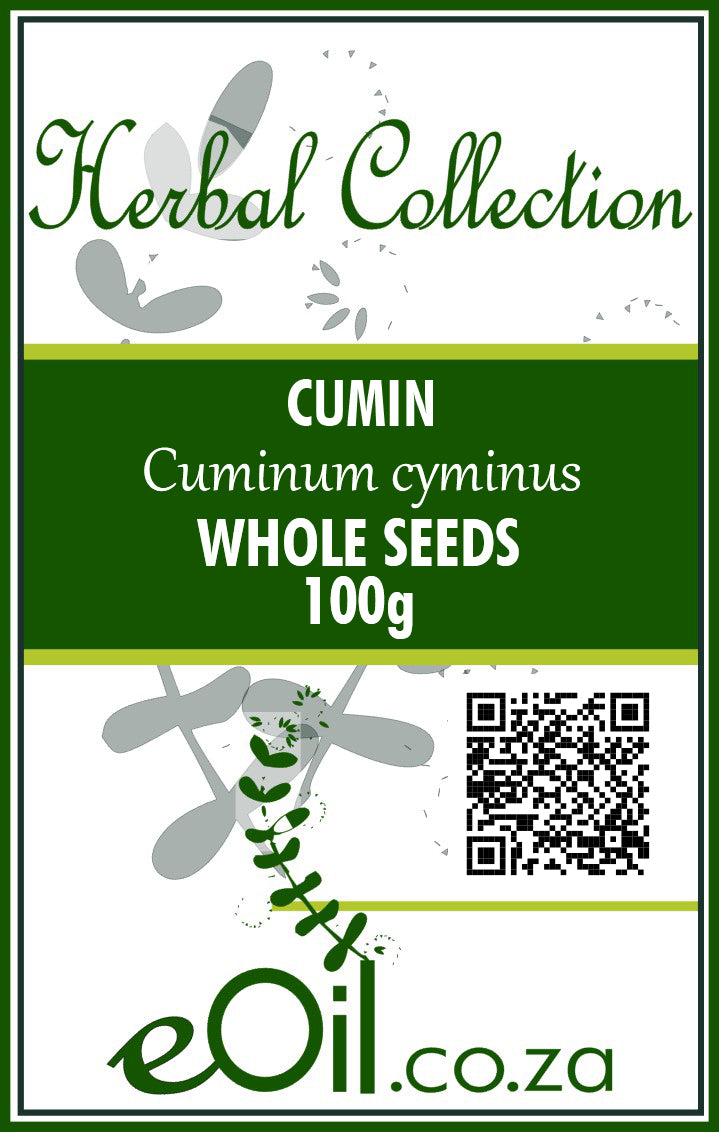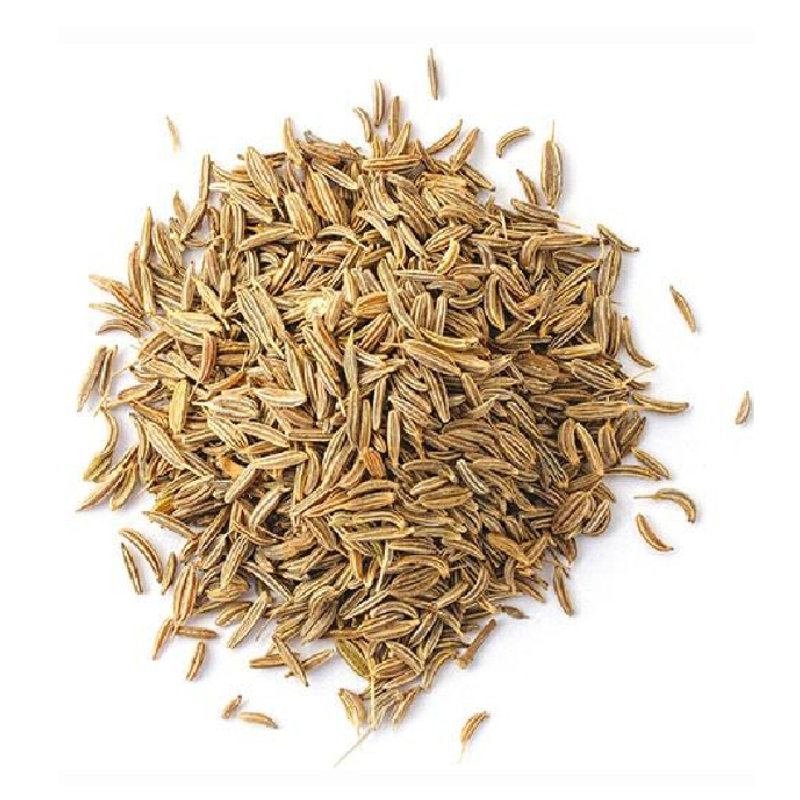Cumin Seeds - Herbal Collection
Cumin Seeds - Herbal Collection - 100 GR is backordered and will ship as soon as it is back in stock.
Description
Description
Cumin Seeds (Cuminum cyminum) are small, elongated seeds with a warm, earthy aroma and a slightly peppery, citrus note.
Widely used in global cuisines, they add depth to curries, stews, rice, and spice blends.
Pure, naturally dried, and free from additives—essential for creative cooking and seasoning
TRADITIONALLY USED FOR
Whole Cumin Seeds: Timeless Culinary Spice & Digestive Remedy
Cumin Seeds from eOil.co.za’s Herbal Collection are high-quality, food-grade seeds of Cuminum cyminum, prized globally for their earthy flavor and potent wellness benefits. These seeds have been central to cuisine and natural herbal medicine for centuries.
Product Features
Cumin Seeds Whole (Cuminum cyminum)
100% pure, dried, food-grade seeds
Essential for curries, chutneys, bread, teas, and wellness remedies
Digestive, antispasmodic, hypoglycemic, cholesterol-lowering
Key Benefits & Traditional Uses
Digestive Health: Cumin seeds are famous for stimulating digestive enzymes, enhancing nutrient absorption, reducing bloating, gas, and indigestion, and acting as a mild laxative.
Antioxidant & Anti-inflammatory: Rich in phytochemicals (cuminaldehyde, flavonoids) and essential oils, cumin seeds fight oxidative stress, protect cells, and reduce inflammation.
Metabolic & Heart Wellness: Promotes cholesterol balance, helps control blood glucose, and may assist with weight management when used regularly.
Immune Support: Vitamins (A, C), iron, and unique compounds contribute to immune health and may help defend against pathogens.
Traditional Ayurveda & Folk Uses: Used across cultures for cough, bronchitis, women’s health, skin, and stimulating appetite.
Basic Certificate of Analysis (COA) Information
Botanical Name: Cuminum cyminum (cumin)
Part Used: Whole dried seeds
Key Phytochemicals: Cuminaldehyde (main aroma/component), limonene, pinene, cymene, flavonoids, saponins, tannins, proteins, minerals (notably iron)
Microbial/Safety: No pathogens or mold in food-grade batches; shelf life 2–3 years in glass airtight containers, 3–4 years optimal
Nutritional Profile: Good source of iron, manganese, some calcium, magnesium, and B vitamins
Instructions for Use
Culinary:
Toast briefly in a dry pan to enhance aroma, then use whole or grind for recipes
Add to breads, curries, pickles, stews, soups—typically ½–2 teaspoons per recipe
Herbal Tea/Infusion:
Simmer 1 teaspoon whole seeds per cup of water for 5–10 minutes. Strain and sweeten if desired. Enjoy after meals to support digestion
Ayurvedic Home Remedies:
Combine cumin with coriander and fennel seeds for “CCF tea”—a gentle digestive tonic
Other: As a mouth freshener (chew a few after meals), or grind into powder for blends/masks (Ayurveda)
Cautions & Safety
Whole seeds are safe in culinary doses during pregnancy; however, excessive, medicinal doses or essential oil should be avoided in pregnancy. Consult your doctor if unsure.
Allergic reactions are rare but possible; start slowly if first use
Large doses may cause excessive body heat, especially in summer
Disclaimer:
For culinary and general wellness information. Not intended to diagnose, treat, cure, or prevent any disease. Consult a healthcare provider for chronic conditions, pregnancy, or high-dose use.
INFORMATION
Source : http://www.wikiphyto.org/wiki/Cumin
Reference on http://www.wikiphyto.org
Translation in English by Google Translate (go to the page of the source linked | on Chrome cellphones go on the 3 dots on the top right and select translate in your preferred language | on laptop right click your mouse and select option translate when hoovering on the page
plant name
Cumin
International Latin denomination
botanical family
Apiaceae
Description and habitat
- Native to Turkestan and Upper Egypt
- Small herbaceous plant, with striated and glabrous stems, with leaves divided into filiform segments, presents white or pink flowers, grouped in umbels which will give seeds (achenes) with a strong aromatic odor
History and tradition
- Was one of the spices sought by explorers during their explorations to India
- It is the essential element for making massalé powder.
Parts used
- Seeds, seed essential oil
Dosage forms available
- Seed tincture (fruit)
- Seed essential oil
Usual dosages
Composition
Main components of the plant
- Fatty acids ( palmitic acid , petroselenic acid , linoleic acid [1]
Main components of buds or young shoots
Main components of essential oil
- Monoterpene aldehydes : cuminal (= cuminaldehyde ) 30 to 50%, alpha-terpinen-7-al 10%, gamma-terpinen-7-al
- Monoterpenes : gamma-terpinene , alpha-terpinene , beta-pinene , para-cymene , alpha-phellandrene , alpha-pinene , myrcene , limonene , beta-phellandrene
- Monoterpenols : alpha-terpineol , terpinene-4-ol
Properties
Plant properties
- Antispasmodic and regulator of the intestinal flora
- Anti-diarrheal (traditional use) [2]
- Antiallergic, antioxidant, anti-platelet aggregation, hypoglycemic [3]
- Antidiabetic [4]
- Lipid-lowering (review of clinical studies) [5]
Bud properties
Properties of essential oil
- Eupeptic, aperitif, carminative
- Nervous, calming sedative
- Analgesic, antispasmodic
- Anti-inflammatory [6]
- Antidiabetic by inhibition of aldose reductase and alpha-glucosidase ( cuminaldehyde ) [7] , decreases glycated hemoglobin and improves predictors of diabetes [8]
- Nitric-oxide synthase inhibitor [9]
- Antifungal [10] , against ''Candida albicans'' [11] , Aspergillus [12]
- Antimicrobial ( cuminaldehyde ) [13]
- Miticide, strong activity against Rhipicephalus (Boophilus) microplus (cattle tick from tropical regions) [14]
- Insecticidal properties [15]
- Hormonal effects, leads to endometrial hyperplasia with elevated estradiol and antiprogesterone properties [16]
Directions
Indications of the whole plant (phytotherapy)
- Digestive disorders of various etiologies
- Hyperlipidemia and type 2 diabetes (better control than with glibenclamide) [17]
Indications of the bud (gemmotherapy)
Specific indications of essential oil (aromatherapy)
- Dyspepsia, colitis, flatulence, constipation, aerophagia
- candidiasis
- Diabetes [8]
- Asthma, asthmatic bronchitis
- Osteo-articular pain, rheumatism
- Impotence, frigidity
- Asthenia, insomnia, nervous exhaustion
- Hyperthyroidism (?)
- Estrogenic
Known or suspected mode of action
Usual formulations
Regulations
Possible side effects and precautions for use
- HE not recommended during pregnancy
- Caution in case of hypothyroidism ( HE )
- No sign of acute EO toxicity at doses up to 2000 mg/kg, but hepatotoxic, nephrotoxic and obesogenic effects (weight gain), watch out for estrogenic hormonal effects (avoid in case of hormone-dependent cancer in the woman) [16]
- The NOAEL of Cuminum cyminum essential oil is estimated at 500 mg/kg/d in female Wistar rats [18]
- No prolonged use
- Skin irritation (dermocaustic) possible in pure form
Bibliographic references
- Aller↑ Bettaieb I, Bourgou S, Sriti J, Msaada K, Limam F, Marzouk B. Essential oils and fatty acids composition of Tunisian and Indian cumin (Cuminum cyminum L.) seeds: a comparative study. J Sci Food Agric. 2011 Aug 30;91(11):2100-7. doi: 10.1002/jsfa.4513. PMID 21681765
- Aller↑ Sahoo HB, Sahoo SK, Sarangi SP, Sagar R, Kori ML. Anti-diarrheal investigation from aqueous extract of Cuminum cyminum Linn. Seed in Albino rats. Pharmacognosy Res. 2014 Jul;6(3):204-9. doi: 10.4103/0974-8490.132596. PMID 25002800
- Aller↑ Sowbhagya HB. Chemistry, technology, and nutraceutical functions of cumin (Cuminum cyminum L): an overview. Crit Rev Food Sci Nutr. 2013;53(1):1-10. doi: 10.1080/10408398.2010.500223. PMID 23035918
- Aller↑ A. Willatgamuwa, S & Platel, Kalpana & Saraswathi, Gurram & Srinivasan, Krishnapura. (1998). Antidiabetic influence of dietary cumin seeds (Cuminum cyminum) in streptozotocin induced diabetic rats. Nutrition Research - NUTR RES. 18. 131-142. 10.1016/S0271-5317(97)00207-8.
- Aller↑ Hadi A, Mohammadi H, Hadi Z, Roshanravan N, Kafeshani M. Cumin (Cuminum cyminum L.) is a safe approach for management of lipid parameters: A systematic review and meta-analysis of randomized controlled trials. Review. Phytother Res. 2018 Nov;32(11):2146-2154. doi: 10.1002/ptr.6162. PMID 30088304 .
- Aller↑ Wei J, Zhang X, Bi Y, Miao R, Zhang Z, Su H. Anti-Inflammatory Effects of Cumin Essential Oil by Blocking JNK, ERK, and NF-κB Signaling Pathways in LPS-Stimulated RAW 264.7 Cells. Evid Based Complement Alternate Med. 2015;2015:474509. doi: 10.1155/2015/474509. PMID 26425131
- Aller↑ Lee HS. Cuminaldehyde: Aldose Reductase and alpha-Glucosidase Inhibitor Derived from Cuminum cyminum L. Seeds. J Agric Food Chem. 2005 Apr 6;53(7):2446-50. PMID 15796577
- ↑ Aller à :8.0 and 8.1 Jafari S, Sattari R, Ghavamzadeh S. Evaluation the effect of 50 and 100 mg doses of Cuminum cyminum essential oil on glycemic indices, insulin resistance and serum inflammatory factors on patients with diabetes type II: A double -blind randomized placebo-controlled clinical trial. J Tradit Complement Med. 2016 Dec 21;7(3):332-338. doi: 10.1016/j.jtcme.2016.08.004. eCollection 2017 Jul. PMID 28725629
- Aller↑ Kermani M, Azizi P, Haghparast A. The role of nitric oxide in the effects of cumin (Cuminum Cyminum L.) fruit essential oil on the acquisition of morphine-induced conditioned place preference in adult male mice. Chin J Integr Med. 2012 Jan 12. PMID 22241501
- Aller↑ Kedia A, Prakash B, Mishra PK, Dubey NK. Antifungal and antiaflatoxigenic properties of Cuminum cyminum (L.) seed essential oil and its efficacy as a preservative in stored commodities. Int J Food Microbiol. 2014 Jan 3;168-169:1-7. doi: 10.1016/j.ijfoodmicro.2013.10.008. PMID 24211773
- Aller↑ Naeini A, Naderi NJ, Shokri H. Analysis and in vitro anti-Candida antifungal activity of Cuminum cyminum and Salvadora persica herbs extracts against pathogenic Candida strains. J Mycol Med. 2014 Mar;24(1):13-8. doi: 10.1016/j.mycmed.2013.09.006. PMID 24210587
- Aller↑ Mohammadpour H, Moghimipour E, Rasooli I, Fakoor MH, Alipoor Astaneh S, Shehni Moosaie S, Jalili Z. Chemical Composition and Antifungal Activity of Cuminum cyminum L. Essential Oil From Alborz Mountain Against Aspergillus species. Jundishapur J Nat Pharm Prod. 2012 Spring;7(2):50-5. PMID 24624154
- Aller↑ Wanner J, Bail S, Jirovetz L, Buchbauer G, Schmidt E, Gochev V, Girova T, Atanasova T, Stoyanova A. Chemical composition and antimicrobial activity of cumin oil (Cuminum cyminum, Apiaceae). Nat Prod Common. 2010 Sep;5(9):1355-8. PMID 20922990
- Aller↑ Martinez-Velazquez M, Castillo-Herrera GA, Rosario-Cruz R, Flores-Fernandez JM, Lopez-Ramirez J, Hernandez-Gutierrez R, Lugo-Cervantes Edel C. Acaricidal effect and chemical composition of essential oils extracted from Cuminum cyminum, Pimenta dioica and Ocimum basilicum against the cattle tick Rhipicephalus (Boophilus) microplus (Acari: Ixodidae). Parasitol Res. 2011 Feb;108(2):481-7. doi: 10.1007/s00436-010-2069-6. PMID 20865426
- Aller↑ Giovanni Benelli, Roman Pavela, Riccardo Petrelli, Loredana Cappellacci, Angelo Canale, Sengottayan Senthil-Nathan, Filippo Maggi. Not just popular spices! Essential oils from Cuminum cyminum and Pimpinella anisum are toxic to insect pests and vectors without affecting non-target invertebrates. Industrial Crops and Products, Volume 124, 2018, Pages 236-243, ISSN 0926-6690, https://doi.org/10.1016/j.indcrop.2018.07.048 .
- ↑ Aller à :16.0 and 16.1 Bahareh Haddad, Sepideh Arbabi Bidgolia, Mahnaz Qomic, Jinous Asgarpanah. Organ Toxicity and Estrogen Like Effects of Cuminum Cyminum.L Seed Essential Oil: A Hormonal, Histopathological and Immunohistochemical Study in Female Mice. ARC Journal of Pharmaceutical Sciences (AJPS), Volume 4, Issue 2, 2018, PP 1-11 ISSN No.: 2455-1538 DOI: http://dx.doi.org/10.20431/2455-1538.0402001
- Aller↑ Dhandapani S, Subramanian VR, Rajagopal S, Namasivayam N. Hypolipidemic effect of Cuminum cyminum L. on alloxan-induced diabetic rats. Pharmacol Res. 2002 Sep;46(3):251-5. PMID 12220968
- Aller↑ Taghizadeh M, Ostad SN, Asemi Z, Mahboubi M, Hejazi S, Sharafati-Chaleshtori R, Rashidi A, Akbari H, Sharifi N. Sub-chronic oral toxicity of Cuminum cyminum L.'s essential oil in female Wistar rats. Regul Toxicol Pharmacol. 2017 Aug;88:138-143. doi: 10.1016/j.yrtph.2017.06.007. PMID 28634146
- Nicola S. Iacobellis, Pietro Lo Cantore, Francesco Capasso, Felice Senatore. Antibacterial Activity of Cuminum cyminum L. and Carum caraway L. Essential Oils. J. Agric. Food Chem., 2005, 53 (1), pp 57–61
CAUTION
Store in a cool, dry place, away from light. Keep tightly closed, away from the reach of Children and pets.
Do not exceed the daily dose.
This product is not intended to prevent or cure any form of illness or disease.
If you are pregnant or nursing ; If you have a medical condition or are in the course of medical treatment ; If you are programmed for theater/operation in the near future, please consult your healthcare practitioner before using this product.
This product cannot replace a varied and balanced diet and a healthy lifestyle.
This product has not been evaluated by the SAHPRA for its quality, safety or intended use.
For More Information please check our General Safety Herbal products Page

Cumin Seeds - Herbal Collection - 100 GR is backordered and will ship as soon as it is back in stock.





